Noise Control at Sea and in Port
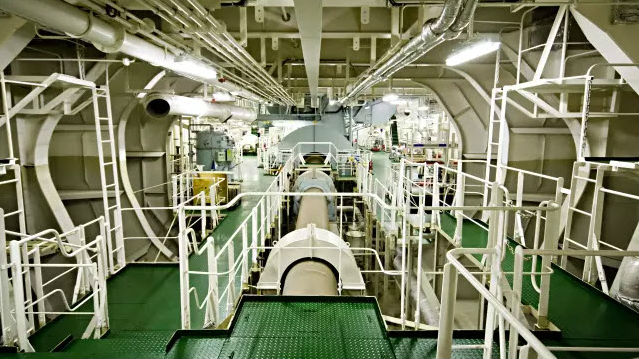
The control of shipping-related noise is an issue that can no longer be ignored. Regulations, studies and technology developments are taking effect around the world, targeting both human and animal welfare, but the news is not all bad for shipowners’ bottom line.
When it came down to it, Celebrity Eclipse didn’t actually require any modifications in order to receive DNV GL’s SILENT-E notation. Impetus for gaining the notation came from the Vancouver Fraser Port Authority’s Enhancing Cetacean Habitat and Observation (ECHO) program. As of January 1, 2017, the port offers discounts to harbor fees for quieter ships, making Canada the first country in the world with such a marine noise reduction incentive.
 Eligible options for reduced rates include ship classification society quiet vessel notations:
Eligible options for reduced rates include ship classification society quiet vessel notations:
* Bureau Veritas Underwater Radiated Noise (URN)
* DNV GL Silent-Environmental (E)
* RINA DOLPHIN.
Cavitation and wake flow reduction technologies also qualify for fee reductions including the use of the Becker Mewis duct, Propeller Boss Cap Fins and the Schneekluth duct.
Captain Zissis Koskinas, Fleet Captain at Celebrity Cruises says it’s not just about the cost savings. “Passengers are often environmentally aware and ask us what we do to protect the environment. Being able to demonstrate that our cruise ship is kind to marine life makes our brand look good and is consistent with the concept of sustainable tourism.”
Power and Propulsion
Sound propagates four times faster in water than in air (1484 m/s versus 343 m/s). The low absorption rate of water makes sound, especially low frequency sound, travel hundreds of kilometers in open sea.

The audible range of hearing for marine fauna spans from five Hz up to about 200 kHz, says SSPA of Sweden. A propeller-driven ship has a number of noise sources: the main and auxiliary engines, electric motors and the flow noise due to turbulence in the boundary layer and the wake of the hull and appendages.
The propeller is a dominant source, generating the highest noise level at frequencies below 200 Hz. If cavitation occurs on propeller blades, the noise level is increased further. Cavitation contributes to both tonal and broadband noise.
As with naval vessels, noise needs to be considered at the initial design stage of commercial ships, says the company. A well-designed hull form will require less power and provide more uniform inflow to propellers, thus increasing the propulsive efficiency and reducing the underwater radiated noise caused by the uneven wake flow.
The propeller design should be carefully matched to optimal efficiency with the most frequently operated speed/draft condition(s). For commercial ships, it is hard to avoid cavitation for efficiency reasons, but cavitation can be controlled and kept to moderate levels, says SSPA. Done correctly, the result is a quieter ship with higher efficiency and lower emissions.
Control Measures
Noise control is no longer a black art, says Raymond Fischer, president of Noise Control Engineering, and noise above and below the water line can be controlled effectively.
There are some simple approaches, he says. Avoid environmentally sensitive areas or slow down when operating in these areas. Other steps are to design for acoustic and economic operation of the propulsor. “Effective hydrodynamic design is likely to be good hydro-acoustic design, especially if CFD analyses are conducted. As vendors develop equipment with lower source levels, these should be utilized as part of a buy-quiet program. These types of programs have been proven to be effective by NASA and the U.S. Bureau of Mines.”
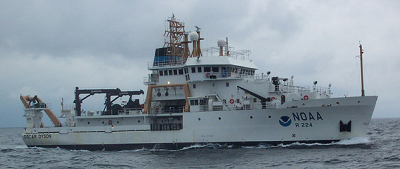 By way of a recent case study, Noise Control Engineering performed a noise analysis, predictions, preliminary testing and trials on the NOAA fisheries research vessel Oscar Dyson. The noise levels in the aft staterooms were found to be controlled by airborne and secondary structure-borne noise from the gensets. This was expected since the diesel generators were mounted on two-stage resilient mounts, and the source vibration of the electric motor was low. Noise in the forward stateroom was controlled by secondary structure-borne noise alone.
By way of a recent case study, Noise Control Engineering performed a noise analysis, predictions, preliminary testing and trials on the NOAA fisheries research vessel Oscar Dyson. The noise levels in the aft staterooms were found to be controlled by airborne and secondary structure-borne noise from the gensets. This was expected since the diesel generators were mounted on two-stage resilient mounts, and the source vibration of the electric motor was low. Noise in the forward stateroom was controlled by secondary structure-borne noise alone.
Because the specification for the vessel included so many treatments, there was more noise control specified than was really needed, said Fischer. Therefore, Noise Control Engineering was able to direct efforts to evaluating where treatments could be optimized or removed.
Equipment manufacturers are adding to the body of knowledge available to designers. Flooring provider Sika recently collaborated on a study to quantify the reduction of structure-borne noise by measuring the dampening properties of its flooring products. “The practice for producing measurable values for airborne and impact noise reduction on ships is well established and the performance of these various systems can be quantified,” says Tony Jenkins, SikaFloor Marine Key Account Manager for Shipping. “However, there is currently no ISO standard for measuring structure borne sound and damping properties for marine floors and bulkheads.
“Working with DELTA Acoustics of Denmark, we are now able to measure this reduction of magnitude and provide this information to the acoustic experts involved in the design of vessels.”
Improving Operational Safety
ABS and Singapore Innovation and Research Center are working on using noise and vibration analysis to help improve operational safety. Appropriate noise and vibration levels can enhance safety by improving task performance, habitability, proper functioning of sound sensitive equipment, such as sensors and modern monitoring technologies, as well as whole-body structural integrity at sea. Because vibration on an asset can be global (vibration of the entire structure), local (vibration of selective structural components) or a mix, it has to be considered in a comprehensive way.
ABS is working with partners in Singapore to specifically address tanker noise. The project’s main objective is to validate the development of the noise analysis procedure for large commercial vessels and to address noise issues for existing and newbuild tankers.
In work undertaken with the support of partners National University of Singapore and Singapore Maritime Institute, ABS is also developing a method for rapid analysis of vibration and noise in ship design that gives high-fidelity results with fewer computational resources. The project focuses on developing accurate and efficient algorithms and codes that can be integrated with commercial software. The plan is to create advanced computational tools for analysis and design of ships to mitigate vibration.
ABS also is looking into inappropriate noise levels on board offshore platforms and the resultant effect on task performance and health of personnel, with the launch of another project to develop analysis methods that are appropriate for offshore platforms.
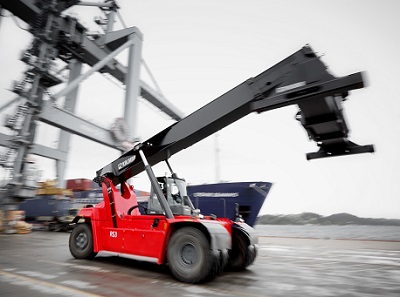 Port-side Solutions
Port-side Solutions
Shoreside, noise guidelines and regulations are being established for ports and terminals. For example, the E.U. has a Noise Management in European Ports (NoMEPorts) document providing guidance and examples of best practice on noise management.
Industry is following with solutions. Kalmar, part of Cargotec, recently delivered five new reachstackers to Barge Terminal Tilburg (BTT) in the Netherlands. BTT serves as an important transportation hub to streamline goods movement between the port of Rotterdam and Tilburg. Four of the reachstackers featured Kalmar’s K-Motion technology that reduces emissions and minimizes noise through drivetrain enhancements and an optimized hydraulic system. Noise control is particularly important, as many of the company’s inland terminals are close to residential areas.
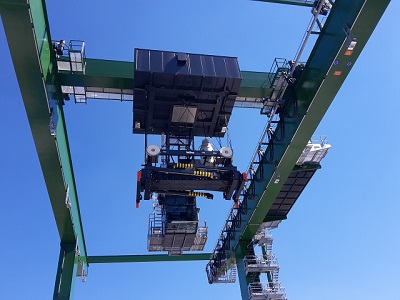 Lase of Germany recently implemented its Load Collision Prevention System for two crane systems at the Intermodal Terminal WienCont in Vienna, Austria, together with the Austrian crane manufacturer Hans Künz. The terminal is one of the biggest container terminals for inland ports in Europe, with approximately 200,000 containers handled annually. Like BTT, the terminal was interested in noise control as it is situated near residential areas. The laser measurement system reduces noise by ensuring containers are pickup up without collision and that they are dropped “softly.”
Lase of Germany recently implemented its Load Collision Prevention System for two crane systems at the Intermodal Terminal WienCont in Vienna, Austria, together with the Austrian crane manufacturer Hans Künz. The terminal is one of the biggest container terminals for inland ports in Europe, with approximately 200,000 containers handled annually. Like BTT, the terminal was interested in noise control as it is situated near residential areas. The laser measurement system reduces noise by ensuring containers are pickup up without collision and that they are dropped “softly.”
Industry-Wide Action
The quest for both understanding and regulation continues to expand across the maritime space. The IMO published MEPC.1/Circ.833 Guidelines for the Reduction of Underwater Noise from Commercial Shipping to Address Adverse Impacts on Marine Life in 2014. Additionally, the IMO recently made changes to onboard noise limits that are mandatory for vessels over 1,600 tons in resolution MSC.337(91). The noise limits provided in the Code on noise levels on board ships are now mandatory under SOLAS.
Other recent developments have seen NOAA in the U.S. publish a roadmap for addressing ocean noise, and the E.U. has completed two large projects looking into the effects of underwater noise in European waters.
As recently as February this year, the U.S. Bureau of Ocean Energy Management (BOEM) awarded a contract to CSA Ocean Sciences, Oasis and Dutch company TNO Maritime & Offshore to study underwater noise during offshore wind farm construction. The main goal of the project – called A Parametric Analysis and Sensitivity Study of the Acoustic Propagation for Renewable Energy Sources and Projects (PASS) – is to provide BOEM with a harmonized acoustic propagation methodology for future environmental impact assessments.
In Australia, scientists from Murdoch University recently studied how well the sound of unmanned aerial vehicles (drones) carries into the water. In this case, they found that drone noise was very close to the background noise levels found in shallow water habitats and below the auditory threshold of the majority of marine mammals.
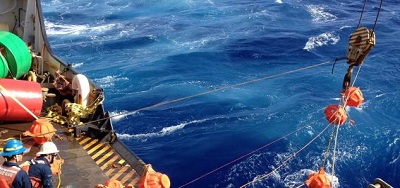 The Last Frontier
The Last Frontier
Last year, scientists listened to the deepest part of the world’s oceans and instead of finding a sea of silence, they discovered a cacophony of sounds both natural and caused by humans.
For three weeks, a titanium-encased hydrophone recorded ambient noise from the ocean floor at a depth of more than 36,000 feet in a trough known as Challenger Deep in the Mariana Trench near Micronesia. The team of researchers from NOAA, Oregon State University and the U.S. Coast Guard expected to hear little.
“You would think that the deepest part of the ocean would be one of the quietest places on Earth,” said Robert Dziak, a NOAA research oceanographer and chief scientist on the project. Yet, the researchers found the sound field was dominated by the sound of earthquakes, both near and far, whale song and the overwhelming clamor of a category 4 typhoon that just happened to pass overhead.
“There was also a lot of noise from ship traffic, identifiable by the clear sound pattern the ship propellers make when they pass by,” said Dziak. “Guam is very close to Challenger Deep and is a regional hub for container shipping with China and The Philippines.”
The project, which was funded by the NOAA Office of Ocean Exploration and Research, was designed to establish a baseline for ambient noise in the deepest part of the Pacific Ocean. Anthropogenic, or human-caused noise has increased steadily over the past several decades and getting these first recordings will allow scientists in the future to determine if the noise levels are growing.
The future could well hold still more industry innovation and regulation as a result.
The opinions expressed herein are the author's and not necessarily those of The Maritime Executive.
